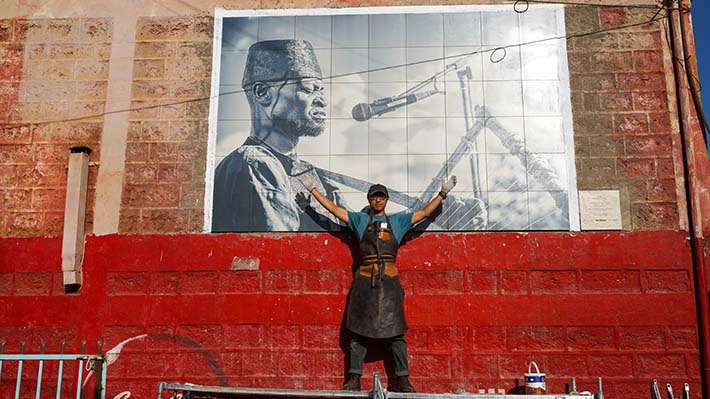|
||||||||||
| Home Nation World Business Opinion Lifestyle ChinAfrica Multimedia Columnists Documents Special Reports |
|
||||||||||
| Home Nation World Business Opinion Lifestyle ChinAfrica Multimedia Columnists Documents Special Reports |
| ChinAfrica |
| Friendship Forged Through Art |
| A Chinese photographer and artist creates a special ceramic artwork to pay tribute to a classical musician from Kenya |
| By Li Xiaoyu 丨VOL. 15 June 2023 ·2023-06-06 |

Qi Lin poses with the image of Ayub Ogada in Kahawa West, a suburb of Kenya’s capital Nairobi, on 12 March 2022 (COURTESY)
A community wall in Kahawa West on the outskirts of Nairobi, Kenya, is decorated with the image of Ayub Ogada. This gigantic mural measuring 3.6 metres wide and 2.4 metres high is made with 54 large ceramic tiles and is hard to miss for passers-by, who inevitably wonder who this man is.
Regarded as one of the greatest Kenyan artists of all time, Ogada passed away over four years ago at the age of 63. In his heyday, he was considered a contemporary virtuoso of the nyatiti, an ancient Kenyan lyre, an excellent djembe player and a leading singer-songwriter. While famous in the Western world, his name is hardly known to Kenyan youth.
Chinese photographer and artist Qi Lin decided to change that with his street art.
A friend at heart
Qi was sent to Kenya in 2011 by AVIC International, for a vocational education project. The photographer first met Ogada on a weekend in 2012 at the African Heritage House in Nairobi, where the musician was performing. “I was overwhelmed by the sight of an old man in traditional dress playing the nyatiti and singing in a long, slow voice, very different from any modern African music I had heard before,” 39-year-old Qi told ChinAfrica.
It was there that Qi took the iconic photo of the musician, with the vast savannah of Nairobi National Park and the Ngong Hills in the background. The following year, Ogada was invited to perform at Qi’s wedding ceremony. From then on, the two men were in regular contact and became very close friends.
Even after he left Kenya in 2015 to follow his wife and pursue his career as a freelance photographer in other countries, Qi continued his friendship with the musician. Whenever he returned to the East African country, he would visit him. When the photographer heard about the musician’s death in early 2019, he was inconsolable.
“Ogada represents not only himself, but the entire African culture. His death is a loss to traditional music in Kenya as a whole,” said Qi. But to his regret, he found that Kenyans did not seem to care much and the mainstream media hardly reported on it.
In June 2021, Qi returned to Kenya with his wife. He came up with the idea of printing Ogada’s picture on a tile wall in a Kenyan community on the third anniversary of his death. He hoped it could make more young people see the late musician’s picture and give him the attention he deserves.
“Nowadays, photos are rarely printed. So, I wanted to explore a new medium to preserve it for a longer period of time,” he explained. “Since the tiles are non-perishable, as long as the wall is not torn down, the mural can stay there and constantly inspire people.”
To make his project a reality, he worked with ceramic artisans from KEDA, a Chinese industrial group that has built the largest East African tile factory in Kenya, to print the photo on the tiles. After gaining approval from the municipality to use the wall, Qi, together with a team from AVIC International, installed the wall tiles within two weeks.
A year after completion, the mural continues to be popular with the public and even international organisations such as the Bill & Melinda Gates Foundation, the Ford Foundation and the UN. Spurred on by such interest, Qi is discussing art projects on ceramic tiles with modern art institutions in East Africa, hoping to involve more Kenyan artists.

A photo taken by Qi Lin shows a pick-up truck carrying an injured camel in Marsabit County, Kenya, on 6 November 2021 (QI LIN)
Qi Lin’s Artistic Experience in Kenya
Influenced by his family, Qi decided to go to Africa in 2011. His maternal grandfather was part of a Chinese medical mission in Somalia over half a century ago. His mother, also a doctor, was sent to Nepal from 2001 to 2003. From a young age, his grandfather told him about his unforgettable experiences in the African continent. But his grandfather’s death in 2015 took away all his memories, leaving behind only a few old photos.
“I am very sad for this loss. Since then, I have decided to record my own story, my mother’s story and the story of Chinese citizens in Africa with my camera,” he told ChinAfrica.
The Chinese living in Africa are one of his most important photographic subjects. He points out that a considerable number of Chinese people on the continent work on infrastructure projects and live together. Local and Western media have less access to the group. The lack of first-hand information sometimes leads to biased reporting. The Chinese media, on the other hand, tends to focus on the major events in Sino-African relations. Qi aims to fill this gap by providing a more realistic account of this group. “When you come here, you will find that every Chinese has his own story. In their own way, they maintain a unique connection with the locals, which is the foundation of Sino-African relations outside the economic and political spheres,” he said.
Besides the Chinese community, Qi also focuses on the ever-changing Kenyan society. From 2011 to the present, he has witnessed the country’s meteoric rise and the huge impact the clash of different cultures has had on Kenya’s traditional customs.
Over the course of a decade, he has visited about 40 of Kenya’s 47 counties. He still remembers how impressed he was when he visited Turkana County for the first time in 2014, especially as he knew it was one of the birthplaces of humanity. He travelled 700 km for two months on a camel, even risking his life. This visit made him think more about his relationship with the world and his condition as a human being, as if he had just returned from a dream in which real and virtual life intermingle.
After this experience, he returned to the north of the country five times. “It’s a piece of land ignored by the rest of the world, but that does not stop it from being affected by the world it belongs to, including tribal conflicts, desertification, climate change or the loss of traditions.”
Qi plans to publish his photo album about his camel experiences later this year.
| About Us | Contact Us | Advertise with Us | Subscribe |
| Copyright Beijing Review All rights reserved 京ICP备08005356号-5 京公网安备110102005860号 |